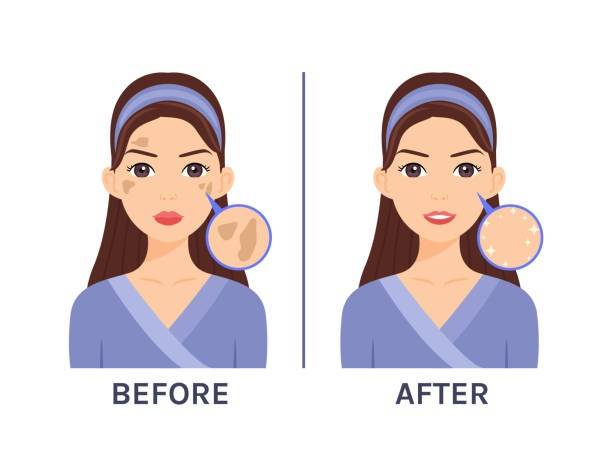Melasma is an extremely common skin condition that presents with dark patches, usually over the face.
What causes melasma?
Melasma is thought to occur due to overstimulation of certain pigment-producing cells by certain triggers, like:
- Sunlight
- Hormonal changes like in pregnancy, thyroid disease, and menopause
- Certain medications, like oral contraceptive pills and anti-epileptics
- Stress
- Blue light (electronic devices)
- In addition, certain individuals are more likely to develop melasma.
- Family history of melasma
- Females
What are some home tips and remedies?
The most important tip that anyone could give for melasma would be sun protection, sun protection, and more sun protection. Wear a wide-brimmed hat while going out on sunny days, and use sunscreen on all days. Electronic devices like our phones, laptops, and TV emit something known as blue light that can worsen melasma, so it’s important to look for sunscreens that protect against blue light as well.

As we know that melasma may be associated with certain triggers, like stress and hormonal changes, it would be beneficial to incorporate yoga into your daily routine. Some yoga poses are thought to have specific benefits for hormonal regulation. For example, certain poses may stimulate the thyroid gland (e.g., sarvangasana or shoulder stand) and help balance thyroid hormones.
These are a few natural home remedies for melasma that may help lighten the dark patches if you have the condition or know someone who does:
- Potato: Our love for potatoes transcends the dining table and has found its way to skin care. Potatoes are known for its mild bleaching properties.
How to use: Slices of potato can be used; alternatively, grated potato can be strained to separate potato juice and mixed with one tablespoon of honey applied over the patch for 20 minutes daily.
- Aloe vera has now become so popular for its skin benefits that it is no longer viewed as just a plant but more like a skin care investment. Apart from its soothing properties, alousin found in the plant has been thought to inhibit the tyrosinase enzyme responsible for pigmentation.
How to use: Sacrifice 2 inches of your plant, use the slimy pulp over your face, and keep for about half an hour minimum.
- Tea tree oil: If you haven’t heard of this yet, you need to run to your nearby store and get some. It is quite versatile and used for acne, dandruff, and as a natural deodorant, in addition to helping lighten dark spots.
How to use: Apply 2–3 drops on the face, let it sit for the whole night, and wash it off in the morning.
- Coffee: We already can’t do without our daily dose of coffee; here’s another reason to love it some more.
How to use: Use coffee powder and honey to make a paste and use it as a face mask for 30 minutes daily; alternatively, lemon juice can be added additionally and used as a spot treatment for 20 minutes daily.
- Onion: Saving the best for last, onion is already a staple in our diet and now our skin care as well. Onion is rich in phytochemicals that help to lighten skin patches.
How to use: Take a slice of onion and rub it over patches. Or alternatively, grate onions, strain the juice, and apply it over the face for 10 minutes daily.
To make sure your skin doesn’t react negatively to any of these treatments, always remember to perform a patch test first. To create a thorough melasma treatment plan, it’s also crucial to speak with a dermatologist. Cases not improving might require medical assistance, such as chemical peels or prescription drugs. Additionally, keep in mind that it can take a few weeks to detect any improvement from your selected home cure, so be patient and persistent.
What are some things to avoid to reduce melasma flaring up?
- Lemon: When life gives you both melasma and lemons, do not try to squeeze some on your skin. Lemons contain citric acid, that acts as a bleaching agent. However, due to its highly acidic nature, you are more likely to irritate the skin rather than heal it.
- Turmeric: Us Indians have been using turmeric on our skin since time immemorial; however, our turmeric is most likely adulterated in recent times, which can lead to irritation, leaving us with two problems instead of the earlier one.
What should my diet be to reduce melasma?
The role of diet is probably the most frequent question we’re asked regarding any condition we diagnose, and melasma is no different. While antioxidant-rich foods alone may not cure melasma, they can be beneficial in maintaining overall skin health and potentially reducing the severity of melasma by protecting the skin from oxidative stress and UV damage. Here are some antioxidant-rich foods that you can incorporate into your diet to support skin health:
- Citrus fruits: Oranges, lemons, and grapefruits
- Tomatoes
- Carrots
- Nuts and seeds: Almonds, sunflower seeds, and chia
- Berries: Blueberries, strawberries, and blackberries
- Sweet potatoes
- Dark chocolate
- Green tea
- Fatty fish: Salmon, mackerel, and sardines
Remember that while incorporating adequate sun protection, home remedies as well as the addition of antioxidant-rich foods into your diet may help improve overall skin health; however, melasma is a complex condition with various contributing factors. It’s important to consult with a dermatologist at Venkat Center Bangalore for a comprehensive treatment plan tailored to your specific needs, which may include topical treatments, sun protection, chemical peels, and laser treatments.
